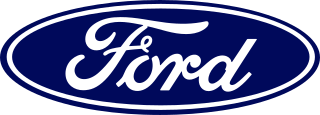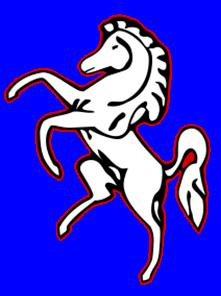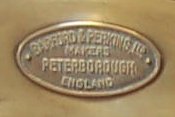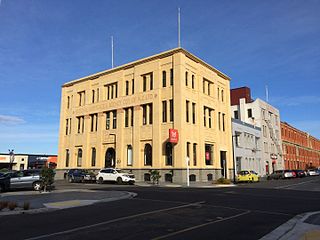
The Birmingham Small Arms Company Limited (BSA) was a major British industrial combine, a group of businesses manufacturing military and sporting firearms; bicycles; motorcycles; cars; buses and bodies; steel; iron castings; hand, power, and machine tools; coal cleaning and handling plants; sintered metals; and hard chrome process.
A holding company is a company whose primary business is holding a controlling interest in the securities of other companies. A holding company usually does not produce goods or services itself. Its purpose is to own shares of other companies to form a corporate group.

A joint-stock company is a business entity in which shares of the company's stock can be bought and sold by shareholders. Each shareholder owns company stock in proportion, evidenced by their shares. Shareholders are able to transfer their shares to others without any effects to the continued existence of the company.

The English Electric Company Limited (EE) was a British industrial manufacturer formed after the armistice of World War I by amalgamating five businesses which, during the war, had been making munitions, armaments and aeroplanes.

Shelvoke and Drewry was a Letchworth, Hertfordshire manufacturer of special purpose commercial vehicles. It was best known for its innovative waste collection vehicles that were the preferred choice of municipal authorities in the UK together with their gully emptiers, cesspool cleaning vehicles and street watering and washing vehicles.

Ford of Britain is a British wholly owned subsidiary of Ford Technologies Limited, itself a subsidiary of Ford International Capital LLC, which is a subsidiary of Ford Motor Company. Its business started in 1909 and has its registered office in Laindon, Essex. It adopted the name of Ford of Britain in 1960.

Karrier was a British marque of motorised municipal appliances and light commercial vehicles and trolley buses manufactured at Karrier Works, Huddersfield, West Yorkshire, by Clayton and Co., Huddersfield, Limited. They began making Karrier motor vehicles in 1908 in Queen Street South, Huddersfield. In 1920, H.F. Clayton sold Clayton and Co's Huddersfield business into public listed company Karrier Motors while keeping their Penistone operation separate. Mechanical and electrical engineers Clayton & Co Penistone, remain active in 2020 as Clayton Penistone Group.
SS Cars was a British manufacturer of sports saloon cars from 1934 until wartime 1940, and from March 1935 of a limited number of open 2-seater sports cars. From September 1935 their new models displayed a new name SS Jaguar.

Aveling-Barford was a large engineering company making road rollers, motorgraders, front loaders, site dumpers, dump trucks and articulated dump trucks in Grantham, England. In its time, it was an internationally known company.

Pressed Steel Company Limited was a British car body manufacturing business founded at Cowley near Oxford in 1926 as a joint venture between William Morris, Budd Corporation of Philadelphia USA, which held the controlling interest, and a British / American bank J. Henry Schroder & Co. At that time the company was named The Pressed Steel Company of Great Britain Limited. It acquired Budd's patent rights and processes for use in the United Kingdom. Morris transferred his interest to his company, Morris Motors Limited.

Barford & Perkins were road roller and agricultural machinery manufacturers in Peterborough, England. The original business began in 1840. Their machinery was distributed internationally.

Blackstone & Co. was a farm implement maker at Stamford, Lincolnshire, United Kingdom.

Dalgety plc—as Dalgety and Company—was for more than a century a major pastoral and agricultural company or stock and station agency in Australia and New Zealand. Controlled from London it was listed on the London Stock Exchange and Australasian exchanges.

A Darracq and Company Limited owned a French manufacturer of motor vehicles and aero engines in Suresnes, near Paris. The French enterprise, known at first as A. Darracq et Cie, was founded in 1896 by Alexandre Darracq after he sold his Gladiator Bicycle business. In 1902, it took effect in 1903, he sold his new business to a privately held English company named A Darracq and Company Limited, taking a substantial shareholding and a directorship himself.

Ransome & Marles Bearing Company Limited was the owner of a business making ball and roller bearings founded during the First World War to make bearings for aircraft and other engines. Before the war most bearings had been imported and most of those were from Germany.
Willans & Robinson Limited manufacturing engineers of Thames Ditton, Surrey. Later, from 1896, at Victoria Works, Rugby, Warwickshire, England. They were manufacturers of stationary reciprocating steam engines then steam turbines, Diesel motors and generators. They also ran their own foundry.
Peter Hooker Limited owned an engineering business originally established in 1827 and carried on under the name Messrs Peter Hooker as printers' engineers at 12 Pump Row, Old Street Road, St Luke's, later at Pear Tree Court, Farringdon Road, London EC. The limited liability company was formed to own it in 1900. Operations were moved to Black Horse Lane Walthamstow, Essex, in 1901.

Peter Brotherhood (1838–1902) was a British engineer. He invented the Brotherhood engine used for torpedoes as well as many other engineering products.
The Laycock Engineering Company Limited of Archer Road, Millhouses, Sheffield, Yorkshire, England was an engineering business established in 1884 by W S Laycock which made small and major components for railway rolling stock.

National Mortgage and Agency Company of New Zealand Limited owned a nationwide stock and station agency business originally intended to invest directly in New Zealand pastoral activities and lend to other participants in that industry. By the 1960s as well as the export of wool and meat and dealing in livestock it provided grain and seed merchandising, wholesale grocery services including wines and spirits and arrangement of property and other real estate sales.













